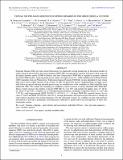YSOVAR: SIX PRE-MAIN-SEQUENCE ECLIPSING BINARIES IN THE ORION NEBULA CLUSTER
Author(s)
Morales-Calderon, M.; Stauffer, J. R.; Stassun, Keivan; Vrba, F. J.; Prato, L.; Hillenbrand, L. A.; Terebey, S.; Covey, Kevin R.; Rebull, L. M.; Terndrup, D. M.; Gutermuth, R.; Song, I.; Plavchan, P.; Carpenter, J. M.; Marchis, F.; Garcia, E. V.; Margheim, S.; Luhman, K. L.; Angione, J.; Irwin, Jonathan M.; ... Show more Show less
DownloadMorales-Calderon-2012-YSOVAR_ SIX PRE-MAIN.pdf (3.465Mb)
PUBLISHER_POLICY
Publisher Policy
Article is made available in accordance with the publisher's policy and may be subject to US copyright law. Please refer to the publisher's site for terms of use.
Terms of use
Metadata
Show full item recordAbstract
Eclipsing binaries (EBs) provide critical laboratories for empirically testing predictions of theoretical models of stellar structure and evolution. Pre-main-sequence (PMS) EBs are particularly valuable, both due to their rarity and the highly dynamic nature of PMS evolution, such that a dense grid of PMS EBs is required to properly calibrate theoretical PMS models. Analyzing multi-epoch, multi-color light curves for ~2400 candidate Orion Nebula Cluster (ONC) members from our Warm Spitzer Exploration Science Program YSOVAR, we have identified 12 stars whose light curves show eclipse features. Four of these 12 EBs are previously known. Supplementing our light curves with follow-up optical and near-infrared spectroscopy, we establish two of the candidates as likely field EBs lying behind the ONC. We confirm the remaining six candidate systems, however, as newly identified ONC PMS EBs. These systems increase the number of known PMS EBs by over 50% and include the highest mass (θ[superscript 1] Ori E, for which we provide a complete set of well-determined parameters including component masses of 2.807 and 2.797 M ☉) and longest-period (ISOY J053505.71–052354.1, P ~ 20 days) PMS EBs currently known. In two cases (θ[superscript 1] Ori E and ISOY J053526.88–044730.7), enough photometric and spectroscopic data exist to attempt an orbit solution and derive the system parameters. For the remaining systems, we combine our data with literature information to provide a preliminary characterization sufficient to guide follow-up investigations of these rare, benchmark systems.
Date issued
2012-07Department
Massachusetts Institute of Technology. Department of PhysicsJournal
Astrophysical Journal
Publisher
Institute of Physics/American Astronomical Society
Citation
Morales-Calderon, M., J. R. Stauffer, K. G. Stassun, F. J. Vrba, L. Prato, L. A. Hillenbrand, S. Terebey, et al. “YSOVAR: SIX PRE-MAIN-SEQUENCE ECLIPSING BINARIES IN THE ORION NEBULA CLUSTER.” The Astrophysical Journal 753, no. 2 (June 25, 2012): 149. © 2012 American Meteorological Society.
Version: Final published version
ISSN
0004-637X
1538-4357